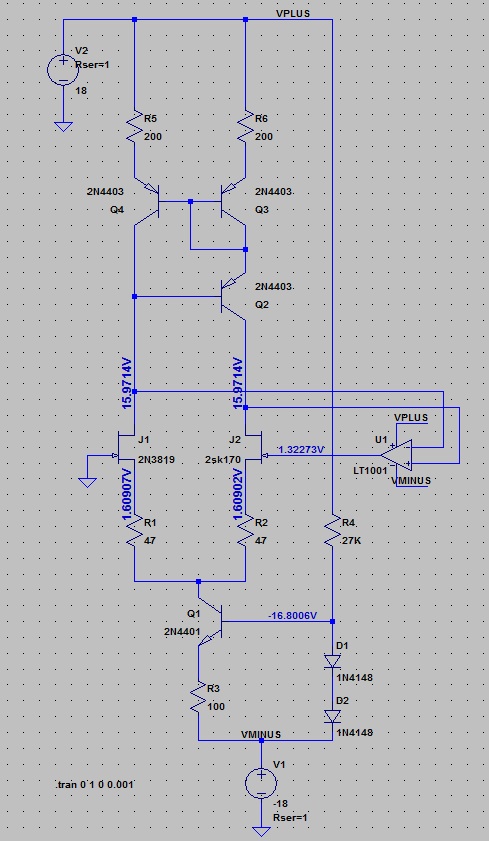I thought I would document the matching process for those that are interested (and for myself to refer to).
It's best to match the devices in a similar operational configuration as they will be used. What better than to use the circuit itself as the matcher!
So in the MP-2, the front end is set up with current mirrors. A constant current is set up through Q1, being equal to roughly 5mA (or two diode drops - VBE divided by R3). In a perfect world, with both JFET's gates grounded and everything else within reason, we should see each JFET passing half of this current equally under similar bias conditions. This only happens if both JFET's are exactly the same.
So the circuit above uses an op-amp to force this to happen. The difference in drain voltages is sensed, and then the op-amp makes it's output whatever it needs to be in order to make this true. In the picture above, I've forced a horrendous pairing by placing an SK170 in one side and a 2N3819 in the other. What you can see is that the op-amp has to apply 1.32V on it's output in order to make the drain voltages the same. This means that the SK170 passes 2.5mA with 1.61 - 1.32 = 0.29 or -0.29 VGS, and the 2N3819 passes the same 2.5mA with -1.61V! This would make a bad differential pair as there would be significant offset being amplified by the rest of the follow-on circuitry.
However what we can do is hang a multimeter on the op-amp's output, and substitute in various SK170 devices and then note down the correction that the op-amp is applying to balance the circuit. If we can find two devices that measure the same corrective offset, then we have a matched pair. If we then place those two devices in the differential positions, the op-amp should be essentially try to drive "ground" (or 0V) in order bring the circuit into equilibrium.
Once two devices are found that are close, we can use Dan's original trick of "source degeneration" to bring them to an exact match. On the layout, R2 includes a trim pot which goes parallel to a fixed resistance. Of we use a 100ohm fixed resistor in parallel with a 1K ohm trim pot, we can dial in the effective R2 anywhere in-between 0ohms and 91ohms. We can tweak this value until the op-amp reads exactly 0V and we have a good match.
A high-precision / low-offset op-amp must be used: I have a stash of OPA2277PA devices that specify offsets in the 20-50uV range. Due to the tremendous open loop gain of this preamp, the matching must be well done in order to keep the output from sitting significantly away from 0VDC, as no coupling capacitor is used. Once the preamp is built, one must again go back and revisit the trimming of R2 to make sure that the output sits at 0V with both JFET inputs grounded. And of course we have feedback to help correct this as well.
Another word to those trying this: run open loop, the temperature of the devices will impact the matching. The circuit needs to "come up to temperature", and should be similar to that inside whatever case you'll be using. I can imagine that even breathing on the test rig will cause the voltages to shift around.




































